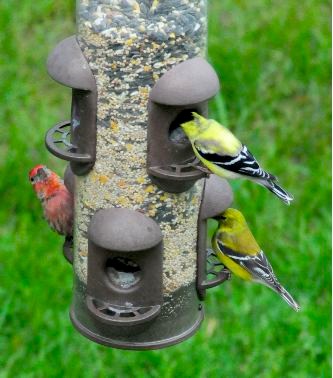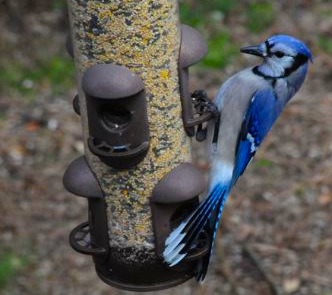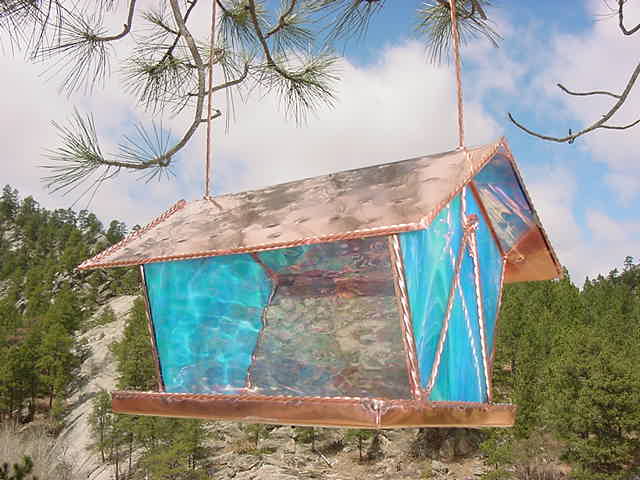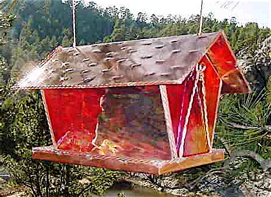-
It takes all kinds…at a tube bird feeder!
 Of all the different seeds available for wild bird feeding, it seems a basic mixed seed attracts a good variety of birds. With a mixed seed in a tube bird feeder, you can expect to see all kinds!
Of all the different seeds available for wild bird feeding, it seems a basic mixed seed attracts a good variety of birds. With a mixed seed in a tube bird feeder, you can expect to see all kinds!Goldfinches and a Purple Finch share this tube bird feeder in harmony. Only seconds later, this juvenile Blue Jay stopped by for a bite to eat too.
Pretty nondescript, it’s your basic tube model. But there are some really cool tube bird feeders hand crafted by artisans, in ceramics and stoneware. The natural-themes in fun designs and sometimes vivid colors can tend to add a great focal point in the garden or landscape.
So if you’re looking to add another feeder, or a first feeder to entice feathered friends… consider a tube bird feeder for a good variety of visitors!

-
2011 Great Backyard Bird Count!
Great Backyard Bird Count Asks for Your Help
Count Birds February 18-21Black-crested Titmouse. Photo by GBBC participant Gregg Lee, Texas.
February 8, 2011—The 14th annual Great Backyard Bird Count is coming up February 18–21, 2011. People of all ages and skill levels are needed to count birds in their yards, neighborhoods, or other locations across the United States and Canada. Simply tally birds for at least 15 minutes on any day of the count, then go to www.birdcount.org and enter the highest number of each species seen at any one time.
Coordinated by the Cornell Lab of Ornithology, Audubon, and Bird Studies Canada, the count provides an instantaneous snapshot of birdlife across the continent for all to see. Anyone can watch as the tallies come in at www.birdcount.org. Organizers hope to receive more than 100,000 checklists during the event, with tallies of more than 600 bird species in all.
Last year’s participants reported more than 1.8 million American Robins, as well as rarities such as the first Red-billed Tropicbird in the count’s history.
“Whether people observe birds in backyards, parks, or wilderness areas, the Great Backyard Bird Count is an opportunity to share their results at www.birdcount.org,” said Judy Braus, Audubon’s vice president of Education and Centers. “It’s fun and rewarding for people of all ages and skill levels–and it gets people outside!”
“When thousands of people all tell us what they’re seeing, we can detect changes in birds’ numbers and locations from year to year,” said Dr. Janis Dickinson, director of Citizen Science at the Cornell Lab of Ornithology.
“While this is the depths of winter in most of Canada and only the hardiest birds brave the cold, understanding of trends in the distribution and abundance at this time of year is important as well,” said Dr. George Finney, president of Bird Studies Canada.
A young GBBC participant carefully makes out her checklist. Photo by GBBC participant Christina Phinney, Michigan. Data from the Great Backyard Bird Count can provide an early signal of changes in bird populations. Past counts showed a drop in reports of American Crows after outbreaks of West Nile virus in 2003, a finding consistent with studies showing crow populations declined by 50–75% in some states. Maps from the count have also captured the paths of migrating Sandhill Cranes and recorded the dramatic spread Eurasian Collared-Doves. Introduced to the Bahamas in the 1970s, the species was reported in just 8 states during the 1999 GBBC. A decade later, it was reported in 39 states and Canadian provinces.
“I have joined the Great Backyard Bird Count for the past three years and am really looking forward to doing it again,” said participant Kathy Bucher of Exira, Iowa. “I really enjoy nature and bird watching. My mother and I share updates on the birds we see. It’s a fun hobby to share with a loved one!”
For more information, including bird-ID tips, instructions, and past results, visit www.birdcount.org. The count also includes a photo contest and a prize drawing for participants who enter their bird checklists online. -
an artful glass bird feeder
 Now glass birdhouses may not be such a great idea as severe weather conditions can wreak havoc on inside temperatures. Extreme heat (if in the line of direct sun) may not be so healthy for eggs or hatchlings.
Now glass birdhouses may not be such a great idea as severe weather conditions can wreak havoc on inside temperatures. Extreme heat (if in the line of direct sun) may not be so healthy for eggs or hatchlings.Glass bird feeders on the other hand, can add a fantastic focal point to the garden or yard. True works of art, the hand crafted glass bird feeders feature a long lost kind of art, and it shows in the craftsmanship.
This copper and stained glass bird feeder features a hand hammered roof, and the generous tray allows for multiple perching spots so several birds can feed at once. The overhang roof helps to protect seed form the elements, while the large capacity hopper holds several ponds of any seed mix. This artist features several vibrant hues of stained glass, and custom work is always a pleasure to create. If you’re stumped for a great Valentine’s gift that will last for years… and actually be admired and enjoyed, consider a work of art – a one-of-kind glass bird feeder in your choice of colors!

